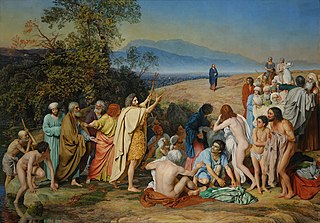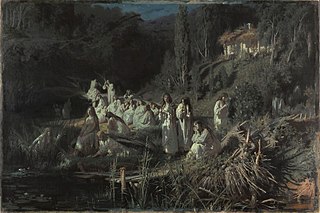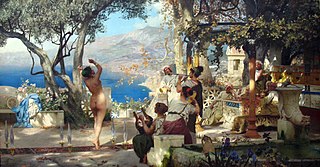 W
WThe Apotheosis of War is a mid 19th century painting by Russian war artist Vasily Vereshchagin. Following his completion of the painting, Vereshchagin dedicated his work "to all great conquerors, past, present and to come". Done in oil on canvas, the painting depicts a pile of skulls outside the walls of a city in Central Asia. It is considered part of Vereshchagin's Turkestan Series.
 W
WThe Appearance of Christ Before the People or The Apparition of the Messiah is an oil painting on canvas, measuring 540 cm × 750 cm, by the Russian painter Alexander Andreyevich Ivanov (1806–1858).
 W
WAt the Dressing-Table. Self-Portrait is a 1909 painting by Russian-French painter Zinaida Serebriakova. The painting is in the collection of the Tretyakov Gallery in Moscow. Its size is 75 × 65 cm.
 W
WThe Beauty is an oil on canvas 1915 painting by the Russian artist Boris Kustodiev.
 W
WChrist in the Desert or Christ in the Wilderness is an 1872 painting by Russian artist Ivan Kramskoi, reflecting the temptation of Christ. Kramskoi was offered a professorship for the painting by the Russian Academy of Arts Council, but having learned that in the beginning of 1873, rejected it. Subsequently, it became one of the favourite paintings of Pavel Tretyakov, who bought it for his gallery in the year the painting was finished.
 W
WThe Demon Downcast is a piece by the Russian painter Mikhail Vrubel, created around 1901-1902.
 W
WThe Demon Seated is an 1890 symbolist piece by Russian artist Mikhail Vrubel.
 W
WThe Empress Elizabeth of Russia on Horseback, Attended by a Page is an equestrian painting of 1743 in the Tretyakov Gallery, Moscow, with several replicas. Done in oil on canvas by Russo-German painter Georg Christoph Grooth, the work depicts Empress Elizabeth of Russia on horseback. The empress is shown dressed in military uniform, attended by a negro page. Elizabeth is shown to be in command of the horse, while her holding of a field marshall's baton represents her command over the sea. The painting was a notable success for Grooth, a former art curator turned painter.
 W
WGirl with Peaches is an 1887 painting by the Russian painter Valentin Serov.
 W
WHomeopathy Looks at the Horrors of Allopathy is an allegorical painting by Russian artist Alexander Beideman, painted in 1857. It is owned by the Tretyakov Gallery in Moscow, Russia. The picture measures 65.5 × 77.3 cm. and has the accession number 1795. In the 19th century, the painting was also known as Triumph of Homeopathy.
 W
WIn High Azure is a painting by Russian artist Arkady Rylov (1870–1939), painted in 1918 in Petrograd. It is exhibited in the Tretiakov Gallery, Moscow.
 W
WIvan the Terrible and His Son Ivan on 16 November 1581 is a painting by Russian realist artist Ilya Repin made between 1883 and 1885. The work is variously referred to as Ivan the Terrible and His Son Ivan, with or without the date, or Ivan the Terrible Killing His Son. The picture portrays a grief-stricken Ivan the Terrible cradling his mortally wounded son, the Tsarevich Ivan Ivanovich. The elder Ivan himself is believed to have dealt the fatal blow to his son. The artist used Grigoriy Myasoyedov, his friend and fellow artist, as the model for Ivan the Terrible, with writer Vsevolod Garshin modelling for the Tsarevich. In 1885, upon completion of the oil on canvas work, Repin sold it to Pavel Tretyakov, for display in his gallery.
 W
WLow Marks Again is a painting by Fyodor Pavlovich Reshetnikov, created in 1952.
 W
WThe Mermaids is an 1871 oil on canvas by the Russian artist Ivan Kramskoi. It depicts nineteen rusalki, who, according to Slavic mythology, were river or lake spirits who appeared at night in the form of young women. Some versions of the myths describe them as spirits who had died unbaptised or unmarried, or had drowned themselves following an unrequited love. They would emerge from the water at night, to sing and dance. They fulfilled a similar folkloric role to sirens; often enchanting young men before luring them to their deaths at the bottom of the water.
 W
WThe Morning in a Pine Forest is a painting by Russian artists Ivan Shishkin and Konstantin Savitsky. The bears were painted by Savitsky, but the art collector Pavel Tretyakov effaced his signature, stating that "from idea until performance, everything discloses the painting manner and creative method peculiar just to Shishkin", so the painting is now credited solely to Shishkin.
 W
WPortrait of an Unknown Woman, also known as The Unknown Woman, An Unknown Lady or Stranger is an oil painting by the Russian artist Ivan Kramskoi, painted in 1883. The model, whose identity is unknown, is a woman of "quiet strength and forthright gaze". It is one of Russia's best-known art works, although a number of critics were indignant when the painting was first exhibited and condemned what they saw as a depiction of a haughty and immoral woman. Its popularity has grown with changes in public taste.
 W
WReligious Procession in Kursk Governorate is a large oil on canvas painting by the Russian realist painter and sculptor Ilya Repin (1844–1930). Completed between 1880 and 1883, the work shows a seething, huddled mass attending the annual religious procession (crucession) carrying the famous icon Our Lady of Kursk from its home at the Korennaya Monastery to the nearby city of Kursk in western Russia.
 W
WSelf-Portrait is an oil-on-canvas painting of 1867 by the Russian artist Ivan Kramskoi. Oval in shape, it is a self-evaluation: Kramskoi indicates how he sees his own facial features and his relationship with the world around him. The artist has rendered himself at 30 years old formally dressed, handsome and intelligent-looking. His pose causes him to be gaze down on the viewer, with an appearance that is, according to the Tretyakov Gallery, "severe and demanding".
 W
WStalin and Voroshilov in the Kremlin is a 1938 painting by Soviet painter Aleksandr Gerasimov. It depicts Soviet leaders Joseph Stalin and Kliment Voroshilov walking near the Moscow Kremlin. Since 1941 it is in the exposition of the Tretyakov Gallery in Moscow.
 W
WThe Sword Dance is an 1881 painting by the Polish painter Henryk Siemiradzki. It is also known as Dance Amongst Daggers, Dance Amongst Swords and similar variations. It depicts a nude woman who dances between swords while a group of women play music and a few men watch. The setting is Italian and there have been several interpretations of what exactly the painting depicts.
 W
WThe Philosophers is an oil on canvas painting executed in 1917 by the Russian artist Mikhail Nesterov which is in the collection of the Tretyakov Gallery, Moscow.
 W
WThe Vision to the Youth Bartholomew is a painting by the Russian artist Mikhail Nesterov, the first and best known work in his series on Sergius of Radonezh, a medieval Russian saint. It is considered "the inaugural work of the Russian Symbolist movement" and is in the collection of the Tretyakov Gallery in Moscow.